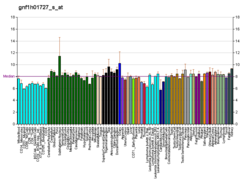ADGRV1, also known as G protein-coupled receptor 98 (GPR98) or Very Large G-protein coupled receptor 1 (VLGR1), is a protein that in humans is encoded by the GPR98 gene. [5] Several alternatively spliced transcripts have been described. [5]
Contents
The adhesion GPCR VLGR1 is the largest GPCR known, with a size of 6300 amino acids and consisting of 90 exons. [6] There are 8 splice variants of VlgR1, named VlgR1a-1e and Mass1.1-1.3. The N-terminus consists of 5800 amino acids containing 35 Calx-beta domains, one pentraxin domain, and one epilepsy associated repeat. Mutations of VlgR1 have been shown to result in Usher's syndrome. Knockouts of Vlgr1 in mice have been shown to phenocopy Usher's syndrome and lead to audiogenic seizures.






